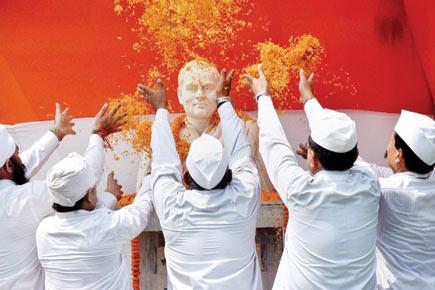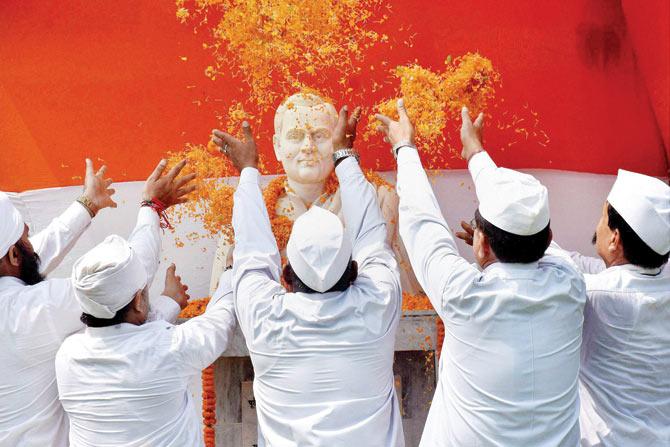Like his reluctant entry in politics, Rajiv Gandhi was also slow to grab opportunities for India’s growth when he was prime minister

Remembering the Reluctant prince: Congress workers pay tribute to former PM Rajiv Gandhi on his 72nd birth anniversary in Patna on Saturday
 Rajiv Gandhi’s recent birth anniversary was yet another occasion for some to tell us what a visionary prime minister he was, and also, that had he lived he would have been a wiser and therefore better PM. This is a contradiction: either he was visionary, or he needed to be wiser. Despite his unprecedented and unrepeated parliamentary majority (414 out of 533 seats), he did not reform the economy the way that Deng Xiaoping did in China (Deng’s tenure also ended in 1989). China has never looked back; India only in the 1990s began incrementally catching up. Today, China tries to bend us to its will; India exults in standing its ground.
Rajiv Gandhi’s recent birth anniversary was yet another occasion for some to tell us what a visionary prime minister he was, and also, that had he lived he would have been a wiser and therefore better PM. This is a contradiction: either he was visionary, or he needed to be wiser. Despite his unprecedented and unrepeated parliamentary majority (414 out of 533 seats), he did not reform the economy the way that Deng Xiaoping did in China (Deng’s tenure also ended in 1989). China has never looked back; India only in the 1990s began incrementally catching up. Today, China tries to bend us to its will; India exults in standing its ground.

Remembering the Reluctant prince: Congress workers pay tribute to former PM Rajiv Gandhi on his 72nd birth anniversary in Patna on Saturday. Pic/PTI
ADVERTISEMENT
Rajiv supposedly laid the foundation of digital India and led the telecom revolution. Our leading tech start-ups, however, long precede him: Shiv Nadar founded HCL in 1976; Azim Premji took his dad’s company, Wipro, into information technology in 1980; Infosys was founded by seven now-famous engineers in 1981; only B Ramalinga Raju’s now-defunct Satyam Computer Services was incubated in 1987. If many of these companies (and others that followed) reached the zenith of global ambition, it is despite the government and not because of it. The private sector laid the foundation for India’s IT revolution.
Rajiv is also credited with the computerisation of Indian Railways; that would be partially true. The railways began computerisation in the late 1960s, but it was limited to accounting and inventory. And, characteristically, the railways were stuck with old computers long after they became obsolete and inadequate even for their limited tasks. The real revolution came in late 1987, with the computerisation of passenger reservations; for those of us who remember being crushed in a shapeless queue for manual reservations (we Indians had no concept of personal space or even queues), it was a religious miracle. The then railways minister, Madhavrao Scindia, earned his spurs as an administrator with this initiative: he sought the upgradation of computers to the most modern machines.
Rajiv enabled this upgradation by relaxing imports, and not just for railways; imports of assembled motherboards led to lower prices — my first personal computer came from the resulting grey market that proliferated in hubs like Delhi’s Nehru Place (now there’s irony). True, he was far keener than the old political class (or powerful labour unions) on computerisation, but perhaps that was less his vision and more his gadget-obssession. (Rajiv’s Congress successor, PV Narasimha Rao, asked son Prabhakara to buy him a computer in 1985.) On balance, Rajiv gets credit for pushing computerisation in India, but that’s about it. He did not even know about the new phenomenon that was beginning to spread by 1991, called the Internet.
Rahul Gandhi has told election rallies that we wouldn’t have mobile phones had it not been for his father. Former telecom engineer Sam Pitroda, who Rajiv inducted into government, agrees. This is revisionism. Rajiv tasked Pitroda with the job of increasing landline connections, but by the time Rajiv was voted out you still had to wait in line for a phone (I got mine two years later, only through a special journalists’ quota). His intentions were good, but his actions just a drop in the bucket: nothing revolutionary.
If anything, some credit might go to India’s first mobile network company, BPL mobiles, started in 1995 by Rajeev Chandrasekhar. At the time, if you recall, making calls was hair-raisingly expensive — around R18 a call and about the same for incoming calls. The experience, though, forced the then PM, AB Vajpayee, to come out with a New Telecom Policy in 1999 that created a corporatised BSNL and revolutionised mobile telephony. In 1999, India had one million mobile subscribers; last October the numbers crossed one billion. It was the marketplace’s revolution.
It is also said that Rajiv would have been a better PM the second time around had he not been assassinated by LTTE operatives in 1991. It is presumptuous to think that he would have even been PM. He died bang in the middle of the election, creating a sympathy wave that gathered his pardty more seats than anyone else — but not a majority. Before the sympathy wave, the trend was unfavourable. It is more likely he would have been either Leader of Opposition or supporting a government from outside. Babri Masjid might still have fallen. And after vetoing Chandra Shekhar’s economic reforms, he might have had to finally give in to economic liberalisation.
Ironically, Rajiv missed the epochal opportunity to fix the economy while he was PM. Lifting controls and ending protectionist policies, state regulations and monopolies like banking: these would have facilitated private sector successes like IT and telecom. And like Deng, Rajiv would today have been remembered as a national icon, not as a party partisan or political dilettante.
Senior journalist Aditya Sinha is a contributor to the recently published anthology House Spirit: Drinking in India. He tweets @autumnshade Send your feedback to mailbag@mid-day.com
 Subscribe today by clicking the link and stay updated with the latest news!" Click here!
Subscribe today by clicking the link and stay updated with the latest news!" Click here!







